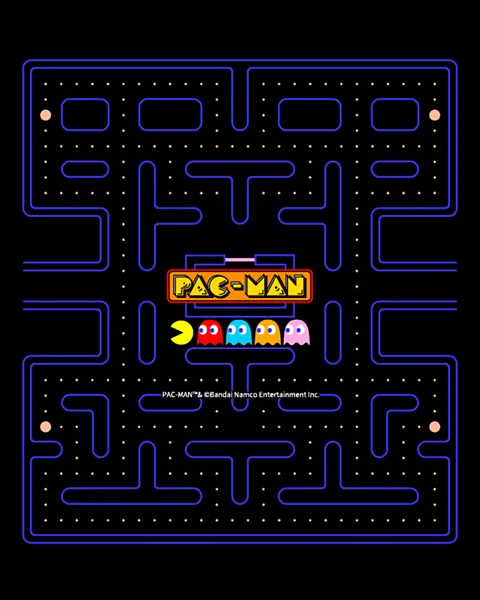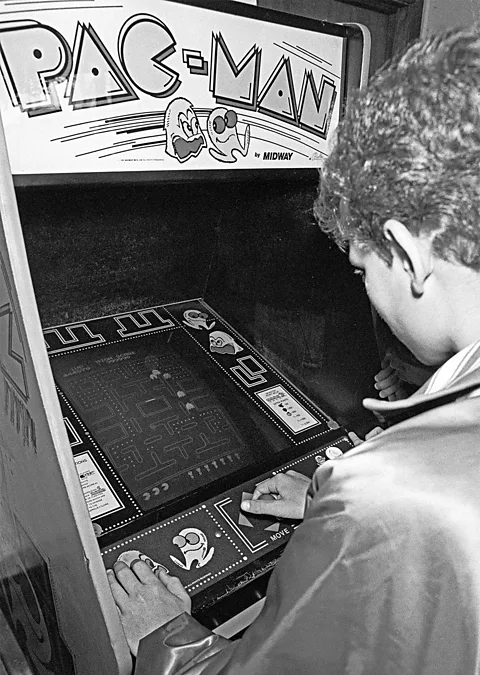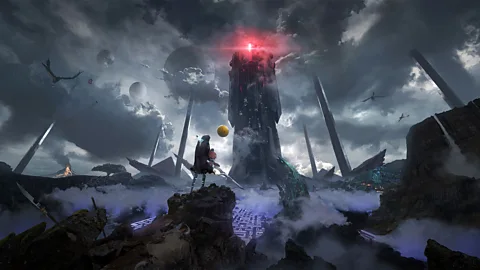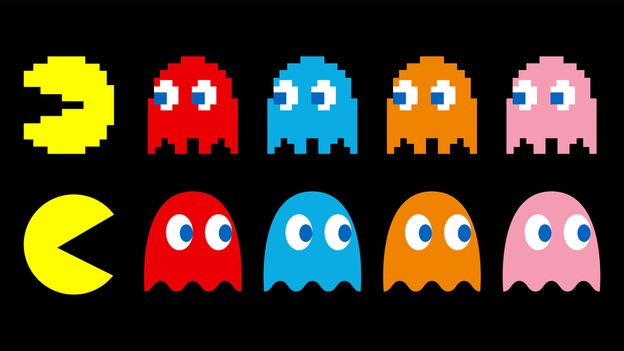Celebrating his 45th birthday this year, the yellow eating machine revolutionised video games – and has even been used in science. What has made him and his adventures so addictive?
The iconic computer game Pac-Man all started in the late 1970s with Toru Iwatani comfort eating a salami pizza. After removing the first slice, the Japanese video game designer got instant chills from the sector-shaped being looking back at him. “If you take a pizza and remove one piece then it looks just like a mouth,” Iwatani told Wired in 2010, confirming this urban legend to be true.
Glancing down at his greasy plate, Iwatani must have known he was eye-to-eye with the perfect gaming character and rapid eating machine – and so, Pac-Man, which this year celebrates 45 years since it was first released in arcades, was born.

 Namco
Namco
In the game, you’re tasked with controlling a greedy yellow blob who must navigate around constantly changing, pitch-black mazes eating as many coins as possible, while also avoiding the clutches of the always-chasing Ghost Gang, which is made up of Blinky (red), Pinky (pink), Inky (cyan), and Clyde (orange).
“Pac-Man [the character] was designed to represent the core concept of the game, ‘to eat’, in the simplest way possible,” Michiko Kumagai, the licensing manager for the iconic character at the game’s publisher, Bandai Namco, tells the BBC. “Just like the McDonald’s arches, he’s become an internationally recognised symbol. At one glance everyone can understand what Pac-Man means instinctively, [which] is why Pac-Man has reached such a wide audience.”
Reach a wide audience it certainly has. Originally called PuckMan in Japan, a reference to the Japanese phrase “paku paku taberu”, which means to gobble something up while producing a greedy, jaw-snapping sound, Pac-Man is the most successful coin-triggered arcade game of all time, according to the Guinness Book of World Records. The character remains an enduring symbol even today, with the franchise having generated an estimated $14bn in revenue, from both arcade machines and dozens of re-releases on home consoles; the games have appeared on everything from the Nintendo Entertainment System [NES] to the Xbox 360.
Pac-Man has also racked up awareness-boosting cameos over recent years in big budget animated kids films including Wreck-It Ralph (2012) and Pixels (2015), while last month Bandai Namco released Shadow Labyrinth, a game that provides a fresh spin on the beloved Pac-Man gameplay.
Why the game works so well
“Pac-Man is one of the figureheads of the birth of mainstream video gaming,” Peter Etchells, professor of science communication at Bath Spa University tells the BBC. “There was an elegant simplicity to its gameplay and design that I think captured a lot of players’ imaginations.”
You don’t need to be a hardcore gamer to appreciate the character’s core purpose of strategic nibbling, with Pac-Man’s gameplay both refreshingly simple and, ultimately, difficult to master. When it came to the original, gamers could either frenetically run around without much thought or, like many people did back in the 1980s, religiously read a How to win at Pac-Man guide that taught you how to memorise hundreds of complex maze patterns and optimal paths. Such tactical preparation would make you war-ready to compete at a Pac-Man tournament – of which thousands have been hosted worldwide.

 Alamy
Alamy
Etchells claims this format was far less driven by testosterone than a lot of Pac-Man’s rivals, and that was a big reason why the game made such a splash. “Pac-Man’s creator Toru Iwatani has specifically said he intended to create a game that everyone could enjoy, and women in particular,” he adds. “Pac-Man, and its colourful sequels like 1982’s Ms Pac-Man, therefore stood apart from the primarily male-geared, shooting-based titles of that era, including Asteroids and Space Invaders, because it focused on a much broader range of demographics.”
Speaking to the Washington Post back in 2020, the game’s creator Iwatani said it also has deeper links to Japanese culture than perhaps first meets the eye. “I designed the ghosts to be simple and cute. This draws on Japan’s age-old appreciation of ‘wabi-sabi’, where people find transient beauty and depth in simplicity. I think the world accepting this Japanese aesthetic more and more, has made more people embrace Pac-Man, too.”
Monkeys have also been playing Pac-Man in recent years. One study discovered a link between certain patterns in monkeys’ eye-movement and their playing decisions – Dr Tom Garner
Beyond its unique design and resonating with global gamers both male and female, Pac-Man has also left an indelible mark on the world of science, with the game, much like Tetris, proving a useful vehicle for researchers to learn about the problem-solving limitations of human, and even chimpanzee, brains. One study by the California Institute of Technology’s Dean Mobbs and colleagues from 2007 subjected Pac-Man players to electrical shocks whenever they were caught by a ghost. “This study used Magnetic Resonance Imaging (MRI) to see if brain activity shifted when the ghosts got too close. It did,” laughs Dr Tom Garner, a senior lecturer in interactive technologies at Sheffield Hallam University.
He continues: “Monkeys have also been playing Pac-Man in recent years. Cornell University’s Z Lin and colleagues (2024) discovered a link between certain patterns in monkeys’ eye-movement and their playing decisions, while the National Library of Medicine used Pac-Man to reveal that macaque monkeys can use strategy-based hierarchical decision-making, previously thought beyond the cognitive capability of non-human animals.
“Video games like Pac-Man have made a substantial impact on the field of scientific research. Pac-Man is a good way of helping us to better understand how humans think, feel, and behave.”

 Namco
Namco
According to Garner, the reason Pac-Man was, and is still, beloved by so many is due to the way it utilises embodiment theory. “In video games, the idea of embodiment describes a sense of connection between the player and the game character that blurs the boundaries between the game world and the real world,” he explains.
“Pac-Man was one of the first video games to place the player in the role of a character as opposed to a vehicle. Pac-Man was represented as a living being, even able to communicate audible pain whenever Blinky, Pinky, Inky, or Clyde caught up with him. All of this resulted in a unique bond with the player.”
The future of Pac-Man
More than 45 years on from its release, Namco Bandai is hoping to boost Pac-Man’s awareness among younger generations through the recently released Shadow Labyrinth. The new game is set in a gigantic sci-fi-meets-medieval maze, where a mysterious figure called Swordman No 8 is guided along by an orb known as Puck, who is like a goth-meets-cyborg spin on Pac-Man’s original design. This pair can also briefly transform into a Transformers-esque robot warrior called GAIA, which allows gamers to overcome otherwise overwhelming puzzles.
Shadow Labyrinth’s producer, Seigo Aizawa, was a Pac-Man fan as a kid and believes the new game can carry on some of the original’s quirks. “I think one of the biggest reasons the world fell in love with Pac-Man is that it was among the first games to give real personality to its characters,” he says. “Each Ghost had a distinct behaviour. Like Blinky, the relentless red Ghost who chases Pac-Man directly, and Pinky, who prefers to ambush from ahead. These traits weren’t just described on the arcade cabinet, they were embedded in the gameplay through each Ghost’s unique AI and movement patterns.”
Thanks to an ingenious gameplay flip, Pac-Man can also fight back against these spooky predators. After consuming a “power pellet” the hunter becomes the hunted, with Pac-Man finally able to consume the pursuing ghosts and create an easier path forward. You must make the most out of this limited window, with the ghosts only turning blue and being defeatable for a small time period. “There’s still nothing more satisfying than being chased by Ghosts, grabbing a Power Pellet, and turning the tables,” adds Aizawa.

 Namco
Namco
Aizawa reveals that Bandai Namco is already considering a Shadow Labyrinth sequel. However, Nao Udagawa – president and CEO of Bandai Namco – concedes that the fact Pac-Man is a voiceless, non-human character, whose gameplay is based on such simple actions, makes keeping the brand fresh more of a challenge than some of his personality-driven peers like, say, Sega’s Sonic or Nintendo’s Mario. ”It is true that Pac-Man as an IP [intellectual property] has less characters and stories to tell compared to other video game characters such as Sonic,” he says.
